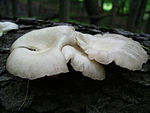Pleurotus ostreatus
Template:Taxobox begin Template:StatusSecure Template:Taxobox image Template:Taxobox begin placement Template:Taxobox regnum entry Template:Taxobox phylum entry Template:Taxobox classis entry Template:Taxobox ordo entry Template:Taxobox familia entry Template:Taxobox genus entry Template:Taxobox species entry Template:Taxobox end placement Template:Taxobox section binomial Template:Taxobox end
The Oyster mushroom, or Pleurotus ostreatus, is a common mushroom prized for its edibility and lack of confusing look-alikes.
Name
Both the latin and common name refer to the shape of the fruiting body. The latin pleurotus (sideways) refers to the sideways-growth of the stem with respect to the cap while the latin ostreatus (and the English common name, oyster) refers to the shape of the cap which resembles the bi-valve of the same name.
Identification

The oyster is one of the more commonly sought wild mushrooms, though it can also be cultivated on straw and other media.
Cap
The cap is smooth; oblong and often convex with age; 50-200 mm in diameter; and ranges from white to brown to blue-gray. The margin can be smooth with a slight wave.
Flesh
The flesh of the most common variety is white and can be thin or thick. A range of different colors can be found in the wild and can be cultivated. Yellow, pink, blue, and gray.
Gills and stem
Gills are decurrent (descend down the stem) and attached and white to light yellow. The stem is short, often horizontal and emerging from wood.
Spores
The spores form a white to lilac-gray print on dark media.
Mycelia
The mycelia is white and grows rapidly.
Standort
This is a wide-spread mushroom in much of North America and other continents. Grows on dead wood year round. All strains need moist conditions to fruit, although different strains fruit in different temperature ranges.
References
- Stamets & Chilton, The Mushroom Cultivator, 1983
- National Audubon Society Field Guide to North American Mushrooms, 1997
